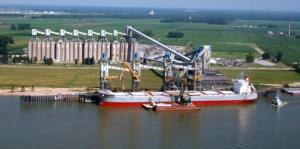Every bushel of U.S. corn, sorghum and barley moving to overseas markets passes thorugh a U.S. export port, a system known worldwide for its efficiency and certification procedures.
The vast majority of this grain bound for international markets is sold in large volume bulk cargo loads. Smaller orders sometimes go out through containers, often through West Coast ports.
Fifty percent of all U.S. grain exported moves through New Orleans, the Pacific Northwest handles approximately 25 percent and the Texas Gulf Coast exports about 11 percent. The remainder goes through ports in California and the East Coast.
From the time grain leaves a farm destined for international trade, there are multiple layers of controls and certifications by numerous independent authorities, all working to ensure integrity of the product and process.
Thomas Russell with The Russell Marine Group, a service agency and freight forwarder in New Orleans and Portland, Oregon, said, “The process is the strictest and most extensive in the world with the final steps taking place in major U.S. ports. Our role is to move our customers’ vessels and products through the process efficiently and without error so they receive their product in a timely manner.�
For the Port of New Orleans, the majority of grain moving to international destinations first arrives by river barge at grain elevators along the Mississippi River. Additional loads arrive by truck or railway. Upon arrival at the elevator, the grain is inspected and quality graded by a government inspector or certified independent company. Because the elevators do not have massive storage capacity, they are constantly unloading grain from barges, trucks and rail cars and preparing it for loading directly onto large cargo ships.
As a cargo ship enters the port to load grain, it receives an inspection by the U.S. Department of Agriculture (USDA). Additionally, the National Cargo Bureau (NCB), a marine surveying organization working under authority of the U.S. Coast Guard, provides inspection to certify the stability of the ship once cargo is loaded. After passing those inspections, a readiness certificate is issued, which means the vessel is ready for loading cargo.
When an agency receives the readiness to charter for a vessel, they file a berth application with the grain elevator, signaling the elevator to schedule the vessel for loading with the buyer’s specified grain.
Once the cargo ship docks at the elevator, another USDA and NCB inspection of the vessel takes place to ensure safety and quality for the remainder of the process. As grain is loaded, it is inspected and quality graded to verify that the grain meets the specifications of the buyer’s contract. Upon loading, weight and inspection certifications are issued for each lot of grain. At this point the elevator or a freight forwarder prepares the export documents so the ship can sail.
“There are many advantages to purchasing U.S. grain,� said Matt Boucree, a manager at Blue Water Shipping, a prominent steamship agency and freight forwarder. “One of them is the ability of international buyers to have export documents in hand the next day after a ship is loaded. That doesn’t happen as fast in other countries.�



